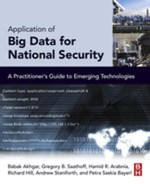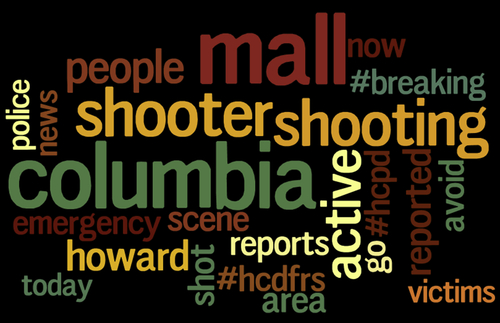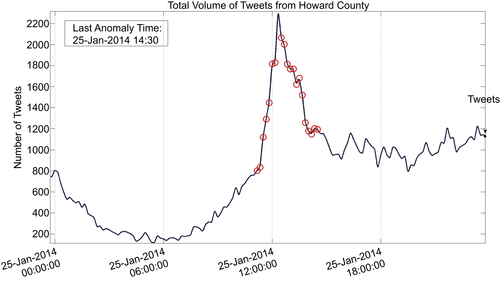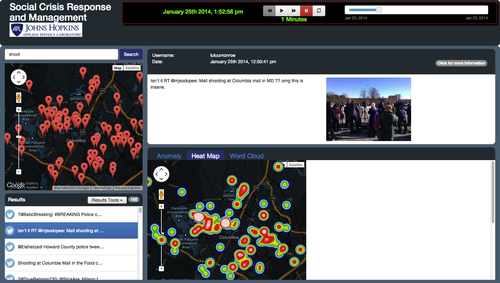Berk R.A, Bleich J. Statistical procedures for forecasting criminal behavior. Criminology & Public Policy. 2013;12(3):513–544.
Blair J.P, Martaindale M.H, Nichols T. Active shooter events from 2000 to 2012. FBI Law Enforcement Bulletin. 2014 January 7, 2014.
Boyd D, Crawford K. Critical questions for big data: provocations for a cultural, technological, and scholarly phenomenon. Information, Communication & Society. 2012;15(5):662–679. doi: 10.1080/1369118X.2012.678878.
Byrne J, Marx G. Technological innovations in crime prevention and policing. A review of the research on implementation and impact. Journal of Police Studies. 2011;20(3):17–40.
Chandola V, Banerjee A, Kumar V. Anomaly detection: a survey. ACM Computing Surveys. 2009;41(3):15:1–15:58. doi: 10.1145/1541880.1541882.
Chang C.-C, Lin C.-J. LIBSVM: a library for support vector machines. ACM Transactions on Intelligent Systems and Technology. 2011;2(3):27:1–27:27. doi: 10.1145/1961189.1961199.
Community Policing Consortium. Understanding Community Policing: A Framework for Action. Washington, DC: Bureau of Justice Assistance; 1994.
Davis III. E.F, Alves A.A, Sklansky D.A. Social Media and Police Leadership: Lessons from Boston. New Perspectives in Policing. March 2014 Available at: http://www.ncdsv.org/images/HKS_Social-media-and-police-leadership-lessons-learned-from-Boston_3–2014.pdf.
Deng J, Dong W, Socher R, Li L.-J, Li K, Fei-Fei L. ImageNet: a large-scale hierarchical image database. In: IEEE Conference on Computer Vision and Pattern Recognition, 2009. CVPR 2009. 2009:248–255. doi: 10.1109/CVPR.2009.5206848.
Duggan M, Smith A. Social Media Update 2013. Pew Research Center’s Internet & American Life Project. 2013 Available at: http://www.pewinternet.org/2013/12/30/social-media-update-2013/.
Endsley M.R. Toward a theory of situation awareness in dynamic systems. Human Factors: The Journal of the Human Factors and Ergonomics Society. 1995;37(1):32–64. doi: 10.1518/001872095779049543.
Federal Bureau of Investigation. Crime in the United States 2012: Violent Crime. Uniform Crime Report Crime in the United States, 2012 (Online). Retrieved: July 16, 2014. 2012 Available at: http://www.fbi.gov/about-us/cjis/ucr/crime-in-the-u.s/2012/crime-in-the-u.s.-2012/violent-crime/violent-crime.
Feinberg J. Wordle-Beautiful Word Clouds (Online). 2009 Available at: http://www.wordle.net.
FEMA. Fire/Emergency Medial Services Department Operational Considerations and Guide for Active Shooter and Mass Casualty Incidents (Online). 2013 Available at: http://www.urmc.rochester.edu/MediaLibraries/URMCMedia/flrtc/documents/active_shooter_guide.pdf.
Fink C, Piatko C, Mayfield J, Chou D, Finin T, Martineau J. The geolocation of web logs from textual clues. In: International Conference on Computational Science and Engineering, 2009. CSE ‘09. vol. 4. 2009:1088–1092. doi: 10.1109/CSE.2009.584.
Friedman J, Hastie T, Tibshirani R. Additive logistic regression: a statistical view of boosting (with discussion and a rejoinder by the authors). The Annals of Statistics. 2000;28(2):337–407.
Garfinkel S.L. Digital forensics research: the next 10 years. Digital Investigation. 2010;7:S64–S73. doi: 10.1016/j.diin.2010.05.009.
Glasgow K, Fink C. Hashtag lifespan and social networks during the london riots. In: Social Computing, Behavioral-Cultural Modeling and Prediction. 2013:311–320 Springer, Berlin, Heidelberg.
Global Justice Information Sharing Initiative. Developing a Policy on the Use of Social Media in Intelligence and Investigative Activities: Guidance and Recommendations. Global Justice Information Sharing Initiative; 2013 Available at: https://www.iadlest.org/Portals/0/Files/Documents/DDACTS/Docs/DevelopSocMediaPolicy.pdf.
Heverin T, Zach L. Twitter for city police department information sharing. Proceedings of the American Society for Information Science and Technology. 2011;47(1):1–7. doi: 10.1002/meet.14504701277.
Heverin T, Zach L. Use of microblogging for collective sense‐making during violent crises: A study of three campus shootings. Journal of the American Society for Information Science and Technology. 2012;63(1):34–47.
Jacobs A. The pathologies of big data. Communications of the ACM. 2009;52(8):36–44. doi: 10.1145/1536616.1536632.
Kleinberg J. The convergence of social and technological networks. Communications of the ACM. 2008;51(11):66–72. doi: 10.1145/1400214.1400232.
LaValle S, Lesser E, Shockley R, Hopkins M.S, Kruschwitz N. Big Data, analytics and the path from insights to value. MIT Sloan Management Review. 2011;52(2):21–32.
La Vigne N.G.L, Lowry S.S, Markman J.A, Dwyer A.M. Evaluating the Use of Public Surveillance Cameras for Crime Control and Prevention Technical Report. Retrieved: July 16, 2014. 2011 Available at: http://www.urban.org/publications/412403.html.
Lazer D, Pentland A.(S.), Adamic L, Aral S, Barabasi A.L, Brewer D, Christakis N, Contractor N, Fowler J, Gutmann M, Jebara T, King G, Macy M, Roy D, Van Alstyne M. Life in the network: the coming age of computational social science. Science (New York, N.Y.). 2009;323(5915):721–723. doi: 10.1126/science.1167742.
O’Hara C.E, O’Hara G.L. Fundamentals of Criminal Investigation. fifth ed. Springfield, IL: Charles C Thomas; 1988.
Police Executive Research Forum. Critical Incidents in Policing Series: The Police Response to Active Shooter Incidents. Washington, DC: Police Executive Research Forum; 2014 Available at: http://www.policeforum.org/assets/docs/Critical_Issues_Series/the%20police%20response%20to%20active%20shooter%20incidents%202014.pdf.
Perry W.L, McInnis B, Price C.C, Smith S.C, Hollywood J.S. Predictive Policing: The Role of Crime Forecasting in Law Enforcement Operations. Rand Corporation; 2013 Available at: https://www.ncjrs.gov/pdffiles1/nij/grants/243830.pdf.
Research and Innovative Technology Administration (RITA)—United States Department of Transportation. Next Generation 9-1-1 Research Overview (Online). Retrieved July 31, 2014. 2014 Available at: http://www.its.dot.gov/ng911/.
Romero D.M, Meeder B, Kleinberg J. Differences in the mechanics of information diffusion across topics: idioms, political hashtags, and complex contagion on twitter. In: Proceedings of the 20th International Conference on World Wide Web. 2011:695–704. doi: 10.1145/1963405.1963503 New York, United States.
Sebastiani F. Machine learning in automated text categorization. ACM Computing Surveys. 2002;34(1):1–47. doi: 10.1145/505282.505283.
Sermanet P, Eigen D, Zhang X, Mathieu M, Fergus R, LeCun Y. Overfeat: Integrated Recognition, Localization and Detection Using Convolutional Networks. 2013 arXiv Preprint arXiv:1312.6229.
Starbird K, Palen L, Hughes A.L, Vieweg S. Chatter on the red: what hazards threat reveals about the social life of microblogged information. In: Proceedings of the 2010 ACM Conference on Computer Supported Cooperative Work. 2010:241–250.



